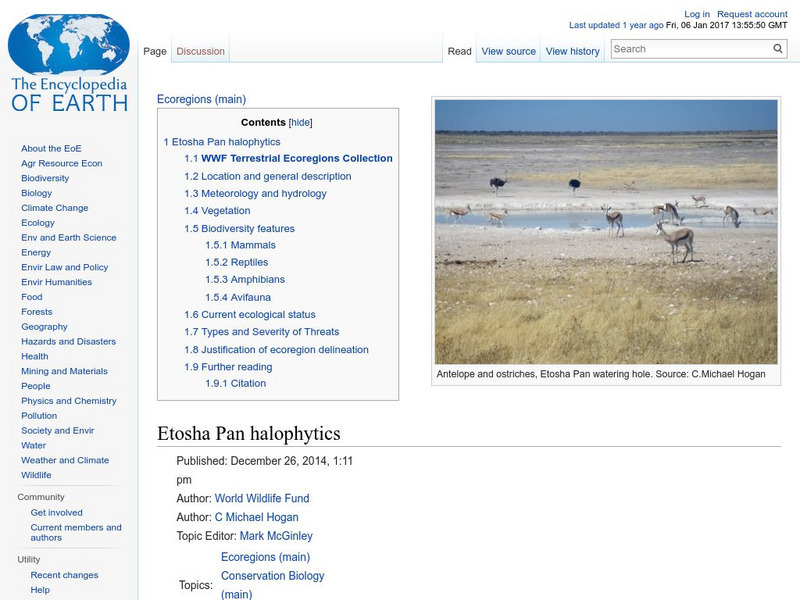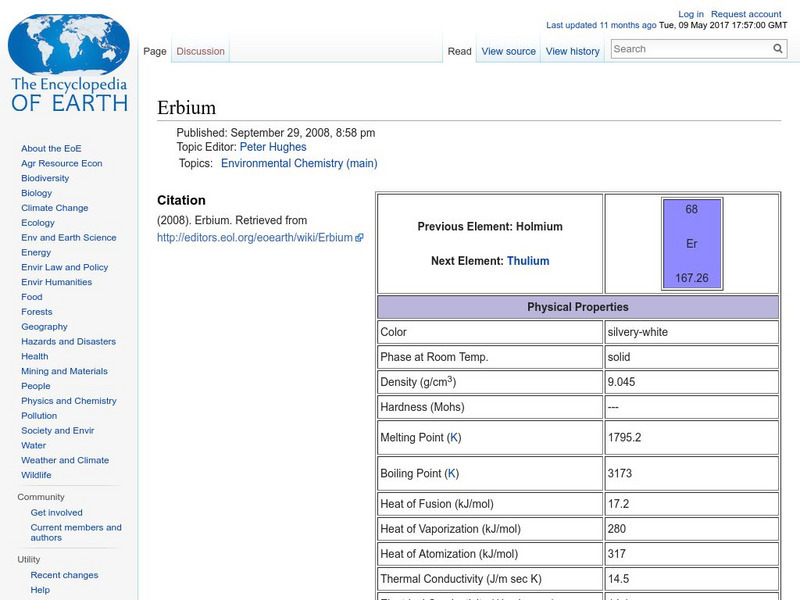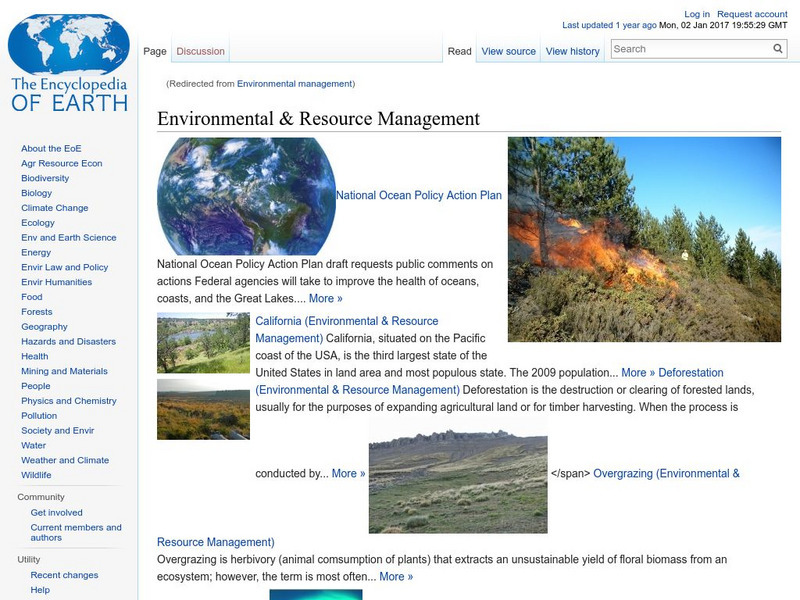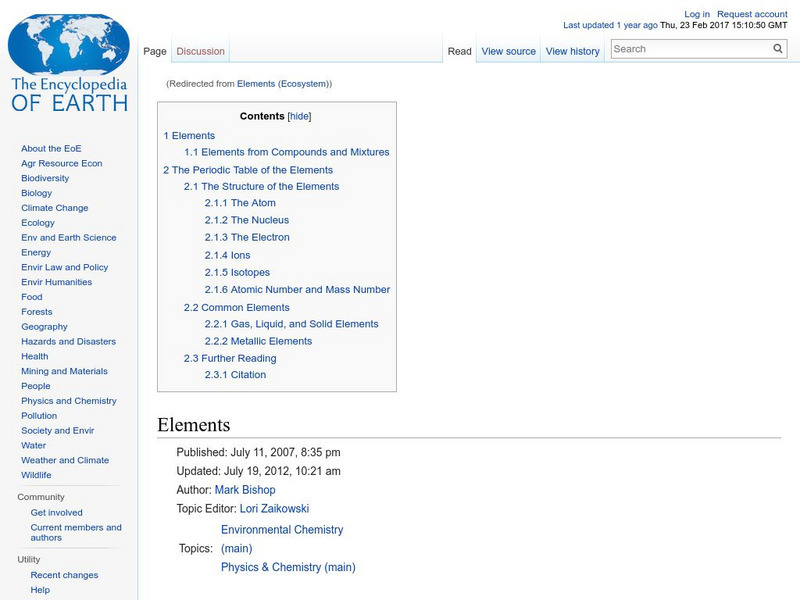Encyclopedia of Earth
Encyclopedia of Earth: Biomes: Etosha Pan Halophytics
Article on the Etosha Pan saline desert in Namibia, which is what remains of a lake from the Pliocene Epoch. Describes its geography, climate, plants and animals, its conservation status, and threats to its biodiversity. (Published:...
Encyclopedia of Earth
Encyclopedia of Earth: Erbium
Information about the element, Erbium, atomic number 68. Covers physical properties, atomic properties, how abundant it is on the Earth, and details about health-related regulations.
Encyclopedia of Earth
Encyclopedia of Earth: Environmental Law & Policy
Read about environmental law and how communities are affected by environmental concerns.
Encyclopedia of Earth
Encyclopedia of Earth: Environmental & Resource Management
A collection of articles on the state of our natural resources and the industries that rely on them, e.g., forests, bodies of water, fisheries and aquaculture, national forests. Many of the articles look at threats to natural resources...
Encyclopedia of Earth
Encyclopedia of Earth: Energy
A collection of articles on energy-related topics, including fossil fuels, conservation, alternative energy, and environmental issues.
Encyclopedia of Earth
Encyclopedia of Earth: Ornithology: Emperor Penguin
Information about the Emperor penguin: physical characteristics, behavior, reproduction, longevity, habitat, diet, conservation status, etc. (Published Jan. 15, 2010)
Encyclopedia of Earth
Encyclopedia of Earth: Elements
Engaging and very informative article that explains what elements are, some of their history, how they are represented, the categories of elements, the periodic table, and how they are structured and classified.
Encyclopedia of Earth
Encyclopedia of Earth: Coal: Coal Fired Power Plants
Discuses how different types of coal-fired power plants work, and their advantages and disadvantages.
Encyclopedia of Earth
Encyclopedia of Earth: Einsteinium
Information about the man-made element, Einsteinium, atomic number 99. Covers physical and atomic properties, how it was discovered, its history, how it is produced, uses, and a list of its isotopes.
Encyclopedia of Earth
Encyclopedia of Earth: Environmental & Earth Science
A comprehensive resource of articles, videos, news and other research opportunities featuring environmental and earth science. References have been created by experts in the field and are useful for researchers and educators to enhance...
Encyclopedia of Earth
Encyclopedia of Earth: Microbiology: Dna
Describes the structure and coding of DNA, how it replicates, and the role it plays at the cellular level. Looks at past and current research on DNA, and applications of this research. (Published: September 25, 2010)
Encyclopedia of Earth
Encyclopedia of Earth: Curium
Information about the element, Curium, atomic number 96. Covers physical properties, atomic properties, how abundant it is on the Earth, and details about health-related regulations.
Encyclopedia of Earth
Encyclopedia of Earth: Coral Reef
Article discussing what a coral reef is, different types, reef biodiversity, and threats to their survival.
Encyclopedia of Earth
Encyclopedia of Earth: Copper
Information about the element, Copper, atomic number 29. Covers its history, sources, physical properties, atomic properties, how abundant it is on the Earth, details about permissible exposure, uses, and possible substitutes.
Encyclopedia of Earth
Encyclopedia of Earth: Conservation Biology
A large collection of scientific articles, news items, and images on a wide range of topics in the field of conservation biology.
Encyclopedia of Earth
Encyclopedia of Earth: Cobalt
Information about the element, Cobalt, atomic number 27. Covers physical properties, atomic properties, how abundant it is on the Earth, and details about health-related regulations, and its importance to human and to animal health. Also...
Encyclopedia of Earth
Encyclopedia of Earth: Ocean Oil: Coastal Ecosystems
A collection of articles, video, and some teaching guides on issues related to coastal ecosystems. Includes environmental issues, e.g., oil spills, and different types of ecosystems, e.g., mangroves and coastal grasslands.
Encyclopedia of Earth
Encyclopedia of Earth: Chromium
Information about the element, Chromium, atomic number 24. Covers discovery, physical and atomic properties, how abundant it is on the Earth, permissible exposure limits, sources, uses, and potential substitutes.
Encyclopedia of Earth
Encyclopedia of Earth: Chlorine
Information about the element, Chlorine, atomic number 17. Covers physical properties, atomic properties, how abundant it is on the Earth, and details about health-related regulations.
Encyclopedia of Earth
Encyclopedia of Earth: Evolutionary Biology: Darwin, Charles
A biography of Charles Darwin.
Encyclopedia of Earth
Encyclopedia of Earth: Changjiang Plain Evergreen Forests
Describes the geography of the Chiangjiang Plain in China, its ecology, its conservation status, and threats to its biodiversity. (Published: August 3, 2007)
Encyclopedia of Earth
Encyclopedia of Earth: Cerium
Information about the element, Cerium, atomic number 58. Covers physical properties, atomic properties, how abundant it is on the Earth, and details about health-related regulations.
Encyclopedia of Earth
Encyclopedia of Earth: Cement
Describes what cement is, where it comes from, uses, and possible substitutes.
Encyclopedia of Earth
Encyclopedia of Earth: Microbiology: Cells
Article describing the parts of a cell. Includes chart listing the main parts of a cell and their definitions. Discusses some of the ways a cell can become damaged. (Published: February 28, 2008)

























